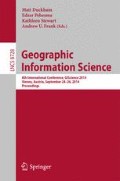Abstract
Indoor evacuation systems are needed for rescue and safety management. A particular challenge is real-time evacuation route planning for the trapped people. In this paper, an integrated model is proposed for indoor evacuation used on mobile phones. With the purpose of employing real-time sensor data as references for evacuation route calculation, this paper makes an attempt to convert sensor systems to sensor graphs and associate these sensor graphs with route graph. Based on the integration of sensing and routing, sensor tracking and risk aware evacuation routes are generated dynamically for evacuees. Experiments of the proposed model are illustrated in the paper. The benefit of the integrated model could extend to hastily and secure indoor evacuation and it potentially presents an approach to correlate environmental information to geospatial information for indoor application.
Access this chapter
Tax calculation will be finalised at checkout
Purchases are for personal use only
Preview
Unable to display preview. Download preview PDF.
References
Richter, K.F., Winter, S., Rüetschi, U.J.: Constructing hierarchical representations of indoor spaces. In: Tenth International Conference in Mobile Data Management, Workshop on Indoor Spatial Awareness, pp. 686–691. IEEE Press, Taipei (2009)
OGC: Indoor geography markup language introduction (2013), http://www.opengeospatial.org/projects/groups/indoorgmlswg
Lee, J., Kwan, M.: A combinatorial data model for representing topological relations among 3D geographical features in micro-spatial environments. International Journal of Geographical Information Science 19(10), 1039–1056 (2005)
Stoffel, E.-P., Lorenz, B., Ohlbach, H.J.: Towards a semantic spatial model for pedestrian indoor navigation. In: Hainaut, J.-L., et al. (eds.) ER Workshops 2007. LNCS, vol. 4802, pp. 328–337. Springer, Heidelberg (2007)
Becker, T., Nagel, C., Kolbe, T.H.: A multi-layered space-event model for navigation in indoor spaces. In: Lee, J., Zlatanova, S. (eds.) 3D Geo-Information Sciences. Lecture Notes in Geoinformation and Cartography, pp. 61–77. Springer, Berlin (2008)
Wu, C., Chen, L.: 3D spatial information for fire-fighting search and rescue route analysis within buildings. Fire Safety Journal 48, 21–29 (2012)
Liu, J., Lyons, K., Subramanian, K., Ribarsky, W.: Semi-automated processing and routing within indoor structures for emergency response applications. In: Buford, J.F., Tolone, W.J., Jakobson, G., Ribarsky, W., Erickson, J. (eds.) Cyber Security, Situation Management, and Impact Assessment II; and Visual Analytics for Homeland Defense and Security II, vol. 7709, p. 77090Z. The International Society for Optical Engineering (2010)
Kraus, L., Stanojevic, M., Tomasevic, N., Mijovic, V.: A decision support system for building evacuation based on the EMILI SITE environment. In: 20th IEEE International Workshops on Enabling Technologies: Infrastructure for Collaborative Enterprises (WETICE), p. 334 (2011)
Han, Z., Weng, W., Zhao, Q., Ma, X., Liu, Q., Huang, Q.: Investigation on an integrated evacuation route planning method based on real-time data acquisition for high-rise building fire. IEEE Transactions on Intelligent Transportation Systems 14(2), 782–795 (2013)
Jiyeong, L.: A three-dimensional navigable data model to support emergency response in microspatial built-environments. Annals of the Association of American Geographers 97(3), 512–529 (2007)
Zhang, L., Wang, Y., Shi, H., Zhang, L.: Modeling and analyzing 3D complex building interiors for effective evacuation simulations. Fire Safety Journal 53, 1–12 (2012)
Tang, F., Ren, A.: GIS-based 3D evacuation simulation for indoor fire. Building and Environment 49, 193–202 (2011)
Lei, Z., Gaofeng, W.: Design and implementation of automatic fire alarm system based on wireless sensor networks. In: Proceedings of the International Symposium on Information Processing, pp. 410–413 (2009)
Nauman, Z., Iqbal, S., Khan, M.I., Tahir, M.: WSN-based fire detection and escape system with multi-modal feedback. In: Dziech, A., Czyżewski, A. (eds.) MCSS 2011. CCIS, vol. 149, pp. 251–260. Springer, Heidelberg (2011)
Sha, K., Shi, W., Watkins, O.: Using wireless sensor networks for fire rescue applications: Requirements and challenges. In: IEEE International Conference on Electro/Information Technology, pp. 239–244. IEEE (2006)
Al-Karaki, J.N., Kamal, A.E.: Routing techniques in wireless sensor networks: A survey. IEEE Wireless Communications 11(6), 6–28 (2004)
Nguyen, M., Ho, T., Zucker, J.: Integration of smoke effect and blind evacuation strategy (SEBES) within fire evacuation simulation. Simulation Modelling Practice and Theory 36, 44–59 (2013)
Stahl, C., Schwartz, T.: Modeling and simulating assistive environments in 3D with the YAMAMOTO toolkit. In: International Conference on Indoor Positioning & Indoor Navigation (IPIN), p. 1 (2010)
Munzer, S., Stahl, C.: Learning routes from visualizations for indoor wayfinding: Presentation modes and individual differences. Spatial Cognition and Computation 11(4), 281–312 (2011)
Stahl, C.: New perspectives on built environment models for pedestrian navigation. In: Spatial Cognition 2008 Poster Proceedings. Universität Freiburg (September 2008)
Stahl, C.: Spatial modeling of activity and user assistance in instrumented environments. PhD thesis, DFKI, University of Saarland (2010)
Chandra, A.M.: Dividing a circular arc into equal numbers of division. IOSR Journal of Mathematics 4, 38–39 (2012)
Stanford University: Geometric algorithms design and analysis (1992), http://graphics.stanford.edu/courses/cs268-09-winter/notes/handout7.pdf
National Fire Protection Association: National Fire Alarm Code. 2007 edn. An International Codes and Standards Organization (2007)
Aziz, N.A.A., Aziz, K.A., Ismail, W.Z.W.: Coverage strategies for wireless sensor networks. In: Proceedings of the World Academy of Science, Engineering and Technology, vol. 50, pp. 145–150 (2009)
American Institute of Chemical Engineers, ed.: DOW’s Fire & Explosion Index Hazard Classification Guide. 7th edn. Wiley (1994)
National Fire Protection Association: Guide on Alternative Approaches to Life Safety. 2013 edn. An International Codes and Standards Organization (2013)
Hart, P.E., Nilsson, N.J., Raphael, B.: A formal basis for the heuristic determination of minimum cost paths. IEEE Transactions on Systems Science and Cybernetics 4(2), 100–107 (1968)
Hart, P.E., Nilsson, N.J., Raphael, B.: Correction to a formal basis for the heuristic determination of minimum cost paths. ACM SIGART Bulletin (37), 28–29 (1972)
Author information
Authors and Affiliations
Editor information
Editors and Affiliations
Rights and permissions
Copyright information
© 2014 Springer International Publishing Switzerland
About this paper
Cite this paper
Wang, J., Winter, S., Langerenken, D., Zhao, H. (2014). Integrating Sensing and Routing for Indoor Evacuation. In: Duckham, M., Pebesma, E., Stewart, K., Frank, A.U. (eds) Geographic Information Science. GIScience 2014. Lecture Notes in Computer Science, vol 8728. Springer, Cham. https://doi.org/10.1007/978-3-319-11593-1_18
Download citation
DOI: https://doi.org/10.1007/978-3-319-11593-1_18
Publisher Name: Springer, Cham
Print ISBN: 978-3-319-11592-4
Online ISBN: 978-3-319-11593-1
eBook Packages: Computer ScienceComputer Science (R0)

